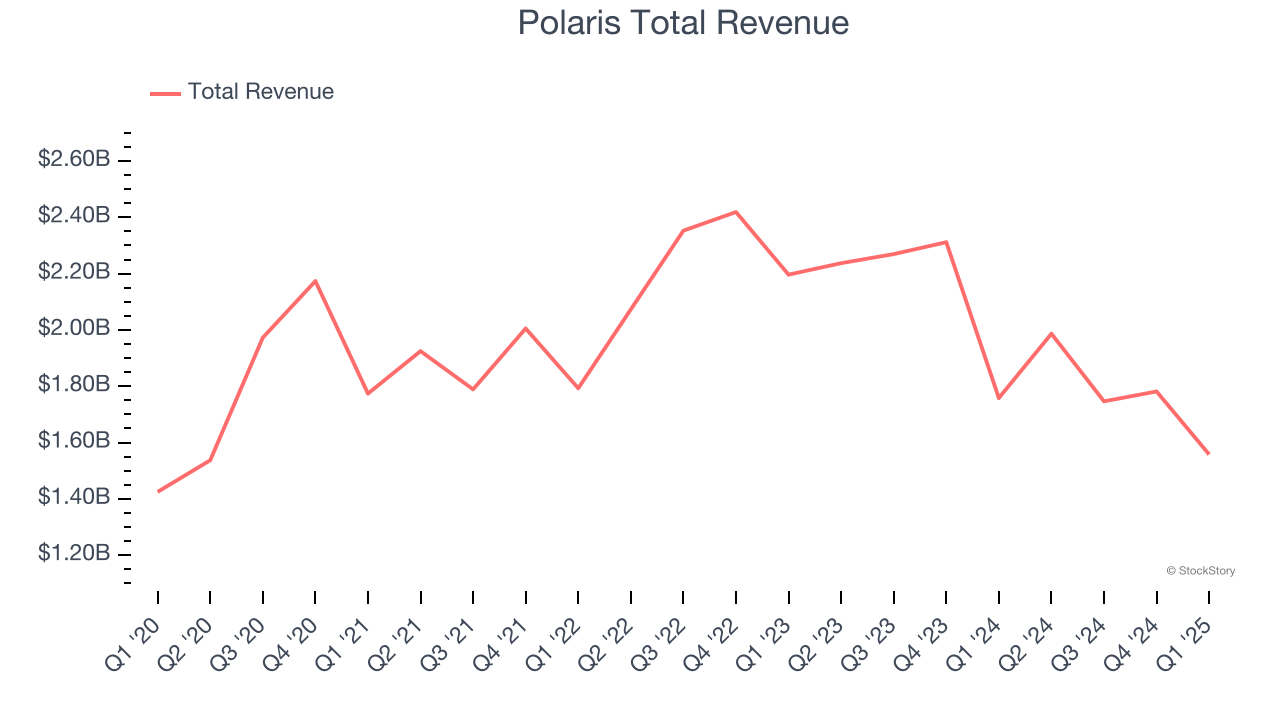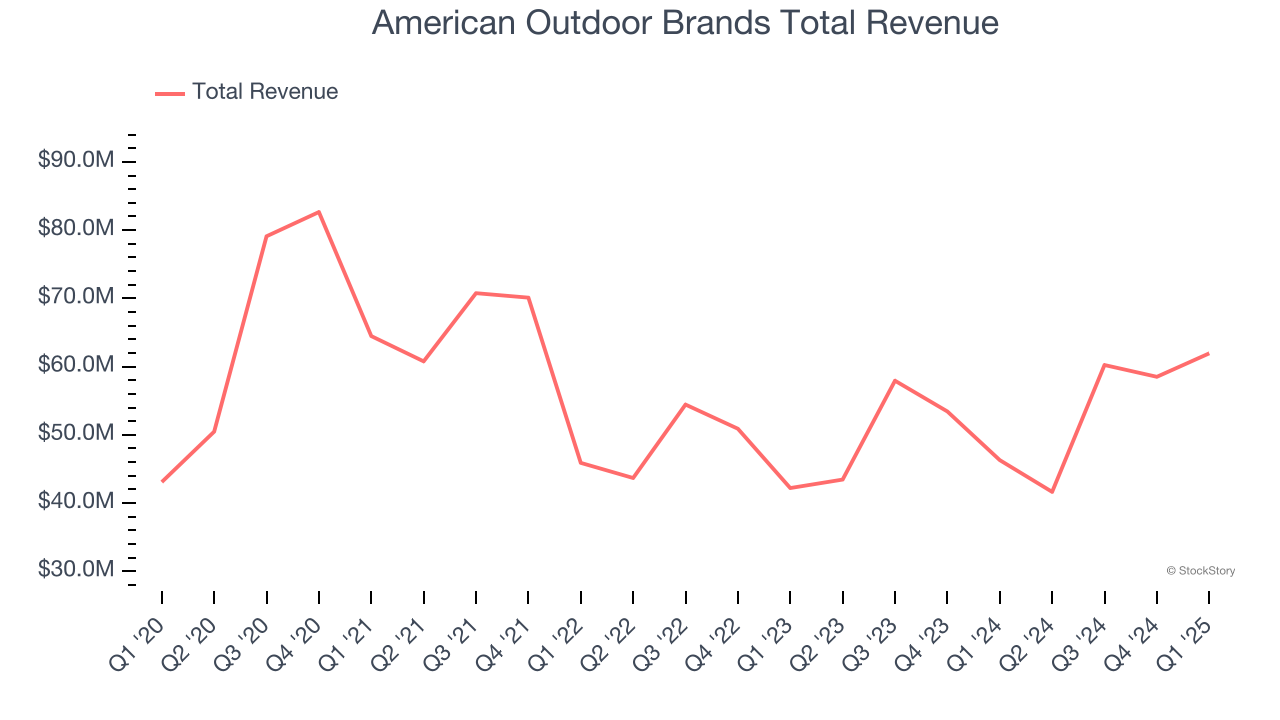
Quarterly earnings results are a good time to check in on a company’s progress, especially compared to its peers in the same sector. Today we are looking at Polaris (NYSE:PII) and the best and worst performers in the leisure products industry.
Leisure products cover a wide range of goods in the consumer discretionary sector. Maintaining a strong brand is key to success, and those who differentiate themselves will enjoy customer loyalty and pricing power while those who don’t may find themselves in precarious positions due to the non-essential nature of their offerings.
The 12 leisure products stocks we track reported a mixed Q1. As a group, revenues beat analysts’ consensus estimates by 2.7% while next quarter’s revenue guidance was 5.1% below.
Luckily, leisure products stocks have performed well with share prices up 11% on average since the latest earnings results.
Polaris (NYSE:PII)
Founded in 1954, Polaris (NYSE:PII) designs and manufactures high-performance off-road vehicles, snowmobiles, and motorcycles.
Polaris reported revenues of $1.56 billion, down 11.4% year on year. This print exceeded analysts’ expectations by 1%. Despite the top-line beat, it was still a mixed quarter for the company with a solid beat of analysts’ EBITDA estimates but revenue guidance for next quarter missing analysts’ expectations.

Interestingly, the stock is up 37.7% since reporting and currently trades at $46.44.
Is now the time to buy Polaris? Access our full analysis of the earnings results here, it’s free.
Best Q1: American Outdoor Brands (NASDAQ:AOUT)
Spun off from Smith and Wesson in 2020, American Outdoor Brands (NASDAQ:AOUT) is an outdoor and recreational products company that offers outdoor and shooting sports products but does not sell firearms themselves.
American Outdoor Brands reported revenues of $61.94 million, up 33.8% year on year, outperforming analysts’ expectations by 27.8%. The business had an incredible quarter with a solid beat of analysts’ EPS estimates and an impressive beat of analysts’ EBITDA estimates.

American Outdoor Brands scored the biggest analyst estimates beat and fastest revenue growth among its peers. Although it had a fine quarter compared its peers, the market seems unhappy with the results as the stock is down 16.3% since reporting. It currently trades at $10.09.
Is now the time to buy American Outdoor Brands? Access our full analysis of the earnings results here, it’s free.
Weakest Q1: Ruger (NYSE:RGR)
Founded in 1949, Ruger (NYSE:RGR) is an American manufacturer of firearms for the commercial sporting market.
Ruger reported revenues of $135.7 million, flat year on year, falling short of analysts’ expectations by 8.3%. It was a disappointing quarter as it posted a significant miss of analysts’ EPS and EBITDA estimates.
Ruger delivered the weakest performance against analyst estimates in the group. As expected, the stock is down 10.2% since the results and currently trades at $36.52.
Read our full analysis of Ruger’s results here.
Acushnet (NYSE:GOLF)
Producer of the acclaimed Titleist Pro V1 golf ball, Acushnet (NYSE:GOLF) is a design and manufacturing company specializing in performance-driven golf products.
Acushnet reported revenues of $703.4 million, flat year on year. This number topped analysts’ expectations by 0.7%. Aside from that, it was a mixed quarter as it also produced a decent beat of analysts’ EPS estimates.
The stock is up 17% since reporting and currently trades at $76.
Read our full, actionable report on Acushnet here, it’s free.
Clarus (NASDAQ:CLAR)
Initially a financial services business, Clarus (NASDAQ:CLAR) designs, manufactures, and distributes outdoor equipment and lifestyle products.
Clarus reported revenues of $60.43 million, down 12.8% year on year. This result beat analysts’ expectations by 7.5%. However, it was a softer quarter as it recorded a significant miss of analysts’ adjusted operating income estimates.
The stock is up 2.6% since reporting and currently trades at $3.59.
Read our full, actionable report on Clarus here, it’s free.
Market Update
As a result of the Fed’s rate hikes in 2022 and 2023, inflation has come down from frothy levels post-pandemic. The general rise in the price of goods and services is trending towards the Fed’s 2% goal as of late, which is good news. The higher rates that fought inflation also didn't slow economic activity enough to catalyze a recession. So far, soft landing. This, combined with recent rate cuts (half a percent in September 2024 and a quarter percent in November 2024) have led to strong stock market performance in 2024. The icing on the cake for 2024 returns was Donald Trump’s victory in the U.S. Presidential Election in early November, sending major indices to all-time highs in the week following the election. Still, debates around the health of the economy and the impact of potential tariffs and corporate tax cuts remain, leaving much uncertainty around 2025.
Want to invest in winners with rock-solid fundamentals? Check out our Top 5 Growth Stocks and add them to your watchlist. These companies are poised for growth regardless of the political or macroeconomic climate.
